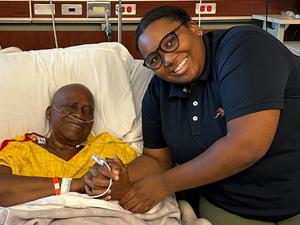This fall Catherine Sneed ’25’s interest in Gullah history took them to Georgia’s Sapelo Island, where they unexpectedly saved a life and, as a result, gained new insights about their own.
Sneed, a political science major, grew up in coastal Georgia surrounded by Gullah people—descendants of Africans who were enslaved on plantations along the southern Atlantic coast and nearby islands, and who speak the Gullah Geechee language. Coming to Wellesley and being away from the community helped Sneed see its uniqueness. “This is all I will have, and I should cherish and, you know, protect it,” they said.
Sneed's grandfather participated in the Gullah Farmers Cooperative Association and sold produce to the community. His involvement sparked Sneed’s curiosity. “What does Black land ownership mean,” they wondered, “and how do we reduce food deserts in coastal communities by empowering and giving resources to Black farmers?”
They had started working on a documentary about the Gullah community and agriculture in high school—a project Sneed revisited this year with their sister after learning that their grandmother planned to resume cultivating blue ribbon sugarcane on the family property for the first time since the 1980s. Sneed said they wanted to document the process of bringing back something that’s so grounded in the area’s Black and Gullah cultures, and explore what it means to modernize it and to teach a new generation about it.
Sneed’s research for the documentary led them and their family to Sapelo Island on Cultural Day, an annual event where visitors are invited to take a ferry to the island and learn about the resident Gullah Geechee community and its traditions. It was a hot, beautiful day, Sneed said. They walked around the festival with a sense of belonging. For someone who admits to struggling with identity—they can’t point to a country on a map and say “This is where I come from”—the community felt like home.

Sneed and their family returned to the ferry after a full day of enjoying the festival. As they stepped from the gangway onto the permanent dock, Sneed heard a loud moan, “like a creature,” and when they turned around they saw that the gangway had collapsed behind them and their family. People were in the water, screaming “Help! Help me! I can’t swim!” Sneed saw a woman struggling in the water, got down on their stomach, grabbed the woman’s hands, and told her she was going to be OK. To keep her calm, Sneed said, they kept talking.
“I told her about graduation. I told her about how my sister and I were born in the same week. I told her about Wellesley,” Sneed said. “I just continued to talk to her because I wanted her to stay awake.”
They held onto each other for approximately 15 minutes until the Coast Guard arrived. Even out of the water, the woman didn’t want to let go of Sneed, so they left the dock together. Sneed learned that the woman’s name was Ms. Bertha and she was a performer at the festival. Her heavy 1800s-style costume was soaked through, so Sneed helped her take it off and gave her the Wellesley sweatshirt Sneed was wearing: “I remember I put it on her, and I told her, ‘You’ll always have a piece of me in the sweatshirt.’”
Eighty-year-old Bertha McKnight survived the accident, but seven others died. Afterward, Sneed struggled with panic attacks and grief. “What I saw was just pure chaos, pure awfulness. Like, people need to know what happened so it doesn’t happen again,” they said. Sneed visited McKnight a in the hospital and was relieved to see her getting better.
Speaking to the media about the accident and seeing McKnight improve allowed Sneed to feel a bit more settled. Now they are trying to recalibrate, they said, and decide how to restart and to move forward with the documentary. One helpful step was receiving the Pamela Daniels ’59 Fellowship this fall through the Office of the Provost, which allowed Sneed to buy some new camera equipment.
Sneed spent Thanksgiving break with their family, helping to harvest sugarcane and recording the process. They hope the documentary will serve as a stepping stone on the way to a career as a television writer.
Sneed said the accident at Sapelo Island has made the unknowns of navigating college and career decisions a bit more manageable. Witnessing a life-and-death event at the age of 22 “is very difficult, but it’s also given me so much peace and clarity and direction,” they said. “It’s like, at the end of the day, certain things I used to stress over don’t matter.”
